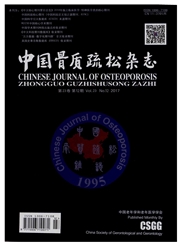

 中文摘要:
中文摘要:
目的明确老年2型糖尿病(T2DM)患者腰椎骨密度及骨折发生率之间的关系。方法每年随访97例老年T2DM患者的糖化血红蛋白,记录骨折等不良事件。于第0、3、7年用DEXA测定腰椎BMD,第7年测定患者及同龄正常对照组(20例)腰椎的DEXA骨密度(aBMD)及QCT骨密度(vBMD)。结果老年(T2DM)患者腰椎aBMD随年龄增长逐渐下降,差异有显著性(P〉0.05),第7年时与第3年时比较仍下降但差异无显著性(P〉0.05)。有13名患者发生非暴力性骨折,糖尿病骨折组、非骨折组及对照组相比,腰椎aBMD均未见显著差异(P〉0.05);糖尿病骨折组vBMD最低,与非骨折组及对照组比较差异有显著性(P〈0.05);多重回归分析腰椎aBMD与糖化血红蛋白相关性差异无显著性(P〉0.05)。结论①老年2型糖尿病患者腰椎aBMD随年龄增长逐渐下降,但与正常同龄人无显著差异;②腰椎aBMD与糖化血红蛋白无显著相关性;②老年T2DM合并骨折病史者腰椎vBMD显著下降但aBMD无显著改变,提示对老年2型糖尿病患者QCT对预测骨折可能具有良好临床应用前景。
 英文摘要:
英文摘要:
Objective To clarify the relationship between type 2 diabetes(T2DM) and bone mineral density(BMD) of the lumbar vertebrae and the incidence of fracture in the elderly.Methods GHB of 97 elderly patients with T2DM was followed up annually.Fractures and other side events were recorded.BMD of the lumbar vertebrae was measured using DEXA on the 0-,3-,and 7-year.aBMD by DEXA and vBMD by QCT in the patient group and normal control group were measured on the 7-year.Results aBMD of elder patients with T2DM in the lumbar vertebrae decreased along with aging,with significant difference.The decrease was not significant comparing to that on the 7-and the 3-year.Unforced fractures occurred in 13 patients.aBMD in the lumbar vertebrae was not significant among T2DM fracture group,non-fracture group,and normal control group.vBMD was the lowest in T2DM fracture group,comparing to that in non-fracture group and in control group(P0.05).Multiple regression analysis showed no correlation between aBMD and GHB(P0.05).Conclusion 1) aBMD decreases along with aging in the lumbar vertebrae of T2DM elder patients,but no significant difference is found comparing to that in normal age-matched people.2) vBMD but not aBMD decreases obviously in elder T2DM patients with fracture history,suggesting that QCT may predict the fracture and had good clinical perspective for the elderly patients with T2DM.
 同期刊论文项目
同期刊论文项目
 同项目期刊论文
同项目期刊论文
 期刊信息
期刊信息
